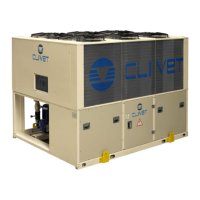M01W45H6-06
WSAT-SC
75C-180F
- ROUTINE MAINTENANCE -
43
- ROUTINE MAINTENANCE -
PREVENTIVE MAINTENANCE
All equipment is subjected to wear out.
The maintenance makes:
1. keeps their efficiency
2. limits breakdowns.
3. Gather information and data to understand the unit efficiency level and prevent possible faults
Therefore, it is fundamental to perform periodical checks: the SERVICES they are mainly cleaning activities, the
INSPECTIONS forseen the unit status and operating check.
The machine should have a logbook used to keep track of the performed controls. This will make fixing up breakdowns
easier. Take note of the date, type of control (autonomous maintenance, inspection or fixing up), description of the
control, actions taken and so on.
BEFORE PERFORMING ANY MAINTENANCE OR CLEANING OPERATIONS, UNPLUG THE UNIT AND MAKE
SURE NO PERSON CAN TURN THE POWER BACK ON.
SERVICES
Parts subject to intervention:
• BATTERIA ARIA ESTERNA
• STRUTTURA
• ELETTROVENTILATORI
EXTERNAL AIR COIL
ATTENTION: contact with the exchanger fins can cause cuts. Wear protective gloves to perform the above-described
operations.
It is extremely important that the battery gives the maximum thermal exchange; therefore, its surface must be cleaned
from dust and deposits. Remove all impurities from the surface.
Using an air pressure gun, clean the aluminium surface of the battery. Be careful to direct the air in the opposite direction
of the fan air movement. Hold the gun parallel to the fins to avoid damages. As an alternative, an aspirator can be used
to suck impurities from the air input side.
Verify that the aluminium fins are not bent or damaged. In the event of damages, contact the authorized assistance
centre and get the battery “ironed out” in order to restore the initial condition for an optimal airflow.
STRUCTURE
Check the condition of the parts making up the structure.
Paint so as to eliminate or reduce oxidation at the points in the unit where this problem may occur. Check that the
panelling is fastened correctly. Poor fastening may give rise to malfunctions and abnormal noise and vibrations. Check
the condition of any gaskets.
ELECTRIC FANS
Make sure that the fans and the relative protection grids are well fixed.
Check, if possible, the unbalances of the electro-fan evident by noise and anomalous vibrations.
Verify that the terminal protection covers are closed and the cable holders are properly positioned
MAINTENANCE INSPECTIONS
Foresee inspection assistance carried out by authorized centres or by qualified personnel.
The inspections should be carried out at least:
• Every year for only the cooling units
• Every six months for the cooling and warming units
The frequency, however, depends on the use: in the event of frequent use (continuous or very intermittent use, near the
operating limits, etc) or critical use (service necessary) it is recommended to plan inspections at close intervals.
The inspections to be performed are as follows:
• check the power supply tension when emptied or filled
• inspect the electrical board (status of solenoid starter contacts, terminal closings, the status of wiring and
relevant insulations)
• inspect the absorption of the single electrical loads
• check the cleaning and the efficiency of the exchangers
• inspect the cleaning of the filters (air/water)
• check the leakage from the refrigerating circuit
• check the protection devices (safety valves, pressure switches, thermostats etc), the control systems, the
control devices (alarm signalling, probe, gauges etc)
• check the operating parameters of the refrigerant circuit (see the following REFRIGERANT TABLES and the
START-UP section)
For units equipped with safety valves, follow the Manufacturer’s instructions.
Verify periodically the cleaning of the safety valves and that oxidative / corrosive phenomena are not present, in
particular for installations near the sea, in industrial areas or in rooms with a corrosive atmosphere.

